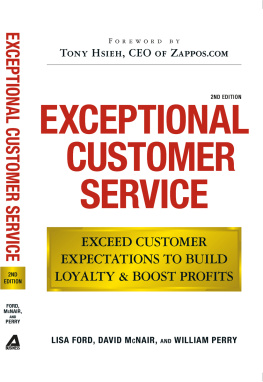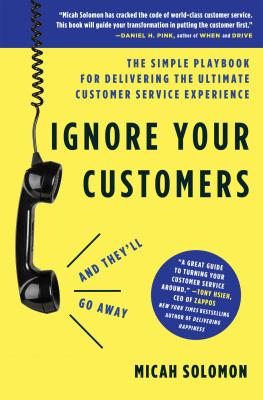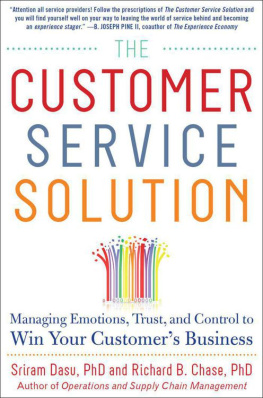
Copyright 2013 by Sriram Dasu and Richard B. Chase. All rights reserved. Except as permitted under the United States Copyright Act of 1976, no part of this publication may be reproduced or distributed in any form or by any means, or stored in a database or retrieval system, without the prior written permission of the publisher.
ISBN: 978-0-07-180999-3
MHID: 0-07-180999-6
E-book conversion by Codemantra
Version 1.0
The material in this eBook also appears in the print version of this title: ISBN: 978-0-07-180993-1, MHID: 0-07-180993-7.
All trademarks are trademarks of their respective owners. Rather than put a trademark symbol after every occurrence of a trademarked name, we use names in an editorial fashion only, and to the benefit of the trademark owner, with no intention of infringement of the trademark. Where such designations appear in this book, they have been printed with initial caps.
McGraw-Hill Education eBooks are available at special quantity discounts to use as premiums and sales promotions or for use in corporate training programs. To contact a representative please visit the Contact Us page at www.mhprofessional.com.
TERMS OF USE
This is a copyrighted work and McGraw-Hill Education, and its licensors reserve all rights in and to the work. Use of this work is subject to these terms. Except as permitted under the Copyright Act of 1976 and the right to store and retrieve one copy of the work, you may not decompile, disassemble, reverse engineer, reproduce, modify, create derivative works based upon, transmit, distribute, disseminate, sell, publish or sublicense the work or any part of it without McGraw-Hill Educations prior consent. You may use the work for your own noncommercial and personal use; any other use of the work is strictly prohibited. Your right to use the work may be terminated if you fail to comply with these terms.
THE WORK IS PROVIDED AS IS. McGRAW-HILL EDUCATION AND ITS LICENSORS MAKE NO GUARANTEES OR WARRANTIES AS TO THE ACCURACY, ADEQUACY OR COMPLETENESS OF OR RESULTS TO BE OBTAINED FROM USING THE WORK, INCLUDING ANY INFORMATION THAT CAN BE ACCESSED THROUGH THE WORK VIA HYPERLINK OR OTHERWISE, AND EXPRESSLY DISCLAIM ANY WARRANTY, EXPRESS OR IMPLIED, INCLUDING BUT NOT LIMITED TO IMPLIED WARRANTIES OF MERCHANTABILITY OR FITNESS FOR A PARTICULAR PURPOSE. McGraw-Hill Education and its licensors do not warrant or guarantee that the functions contained in the work will meet your requirements or that its operation will be uninterrupted or error free. Neither McGraw-Hill Education nor its licensors shall be liable to you or anyone else for any inaccuracy, error or omission, regardless of cause, in the work or for any damages resulting therefrom. McGraw-Hill Education has no responsibility for the content of any information accessed through the work. Under no circumstances shall McGraw-Hill Education and/or its licensors be liable for any indirect, incidental, special, punitive, consequential or similar damages that result from the use of or inability to use the work, even if any of them has been advised of the possibility of such damages. This limitation of liability shall apply to any claim or cause whatsoever whether such claim or cause arises in contract, tort or otherwise.
To Rama and Harri
CONTENTS
PREFACE
We wrote this book because we believe that many companies are leaving some valuable service improvements on the table. These improvements derive from a deeper understanding and application of the psychology that underlies how customers experience the service experience. We propose a collection of approaches for designing systems that deliver experiences. This book is about design and management of service operations.
In writing the book, we cherry-picked experimental research findings of the great minds in behavioral sciences and economicsD. Kahneman, G. F. Lowenstein, E. A. Skinner, V. Folkes, D. Ariely, J. Ledoux, C. E. Izard, D. Gambetta, and R. Larsonand translated them into service principles. We have also interviewed numerous executives and consultants from diverse companies and industries to get examples and share ideas about further application of our ideas in their companies.
The seminal book The Experience Economy by Pine and Gilmore ignited a lot of interest in customer experiences. The premise of the experience economy is that customers buy experiences and are willing to pay a steep premium for them, so managers should try to make these experiences more fun. Our book proposes how service operations can be redesigned using psychological principles to deliver good experiences on a consistent basis. Our concepts and methodology can be applied to any type of service, even services that do not readily lend themselves to theatrical experience conceptsthat is, most everyday businesses. These may be primarily hedonic, like rock concerts and tourism, or largely utilitarian, like retirement planning and care for the chronically ill. As a result, the findings in this book are applicable to many different industries, including healthcare, hospitality, financial services, sports, and e-commerce.
We also believe that our solution addresses the major weakness inherent in service quality improvements from the old total quality management (TQM) to new Six Sigma programsthe lack of the psychological tools and concepts necessary for managers to create optimal service experiences. There are several reasons why existing quality approaches fall short. First, they are far more focused on the employee than on the customer; yes, a motivated, trained employee can do much to improve service, but he or she is limited by focusing on explicit customer expectations, not on implicit customer needs. (We have a lot more to say about this throughout the book.) Second, they are often bureaucratic exercises involving more statistics and scorekeeping than explaining how customers experience services at a subconscious level.
Another part of the problem that is endemic to the service industry, and we find in academia as well, is that the two disciplines that traditionally deal with managing customers in service organizationsoperations management and marketinghavent really gotten on the same page about customer experience management. Marketing people know the concepts we are presenting in the book but have never tried to make them readily applicable to real-world service design and operations management.
It is probably safe to say that we are the first operations management specialists to write such a book. Operations management (OM) is above all an applied field. While it draws upon various disciplines and theories, OM is essentially the design and operation of productive processes, be they manufacturing or service. Its prescriptions must be actionable in the real world: The proof of the pudding is in the eating pretty well sums up the practical nature of the field and the goal of this book. Bon appetit!
ACKNOWLEDGMENTS
We owe a major debt of gratitude to researchers in the behavioral science disciplines of economics, psychology, and sociology. Most notable among these is Nobel Prize winner Daniel Kahneman whose studies of how individuals process information at the subconscious level opened up a whole new way for us to think about service design.
We are deeply indebted to the following executives who were kind enough to let us interview them about service management in their organizations: Paul Allman, personnel training consultant; Odmar Almeida; Agatha Areas, Rock in Rio; Dr. Michele Burnison, Cedars Sinai; Gamal Aziz and Corrine Clement, MGM Hospitality; Krishna Ganugapati; Derrick Hall and Josh Rawitch, Arizona Diamondbacks; Stefan Isser, Swarovski; Ali Kasikci, Orient Express; Tony Knopp, Spotlight Ticket Management; Gary Loveman, Caesars Entertainment Group; Chris McGowan, A.E.G. Sports; Marc Mancini, Mancini Seminars and Consulting; Dr. Mildred Nelson, Christie Clinic; John Severini, California Restaurant Association; Rawn Shaw and James Spohrer, IBM; Mike Simms, Simms Restaurant Group; Dr. Chris Ullman; Becky Uzemeck; Lynne Walker and Shahid Moghul, Dell; and Pete Winemiller, Oklahoma Thunder.
Next page









